The Games of 90s Indie Cinema: “Welcome to the Dollhouse” and “Sex, Lies, and Videotape”
If the aim of “90s independent cinema” (a period more aesthetically than temporally demarcated) is, as critic Michael Newman posits, to “denaturalize aspects of conventional cinematic practice,” then there are few films more exemplary of that playful perversion than Todd Solondz’s Welcome to the Dollhouse (1995) and Steven Soderbergh’s sex, lies, and videotape (1989). In playing with Hollywood notions of mise-en-scene (most notably, costume) and sound (most notably, dialogue and music), these two films urge spectators to regard specific aspects of films as components of a game and to see themselves as the players, the ultimate aspiration being a wholesale reconsideration of the effectiveness of conventional cinematic language.
One common way in which 90s indie films position themselves as “games” is by emblematizing their characters. These distinct yet heavily representative characters seem to collapse into the formal features of the films within which they exist, their aesthetic characteristics/presentation becoming inextricably connected to our interest in the complexity which indie films offer. When these aesthetic choices are made with association in mind (in particular, Hollywood association), the tease of reference often leads the spectator into ‘playing the game,’ intent on deriving a sense of pleasure not always received while watching a Hollywood film. In both Welcome to the Dollhouse and sex, lies, and videotape, that is done through exploring mise-en-scene conventions, emphasis being on costume.
Visual Games
That costume will play an important part in Solondz’s film is immediately discernible, for the very first shot, in long-angle lens, focuses intently on a gawky, female middle-schooler with unfashionable clothes and large glasses. The subsequent pan around the cafeteria reveals a thrum of activity and various classmates, none of whom share her unfortunate attire.
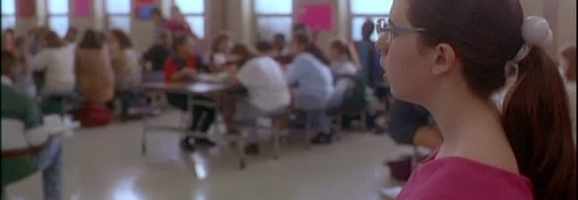
This girl, named Dawn, is alone and without anywhere to sit comfortably, but so is a girl named Lolita, who is dressed in all-black with a sneer to boot. These characters’ costumes draw to mind outcast cultures (nerd and goth), and we would expect them to band together as a result, but our expectations are subverted when Lolita joins in with the group of cheerleaders (oddly enough in uniform despite their being in the cafeteria, not gym) who make fun of Dawn mercilessly.

Dawn’s sister Missy wears a pink ballerina outfit for much of the film, and while her character does not undermine her costume’s associations of purity, grace, and talent, it is precisely the highlighting and exaggeration of such associations that makes Dawn’s mistreatment of her so jarring, thereby assisting in the complexity of Dawn’s character (a character repeatedly made fun of in school but just as disparaging to others in her family).
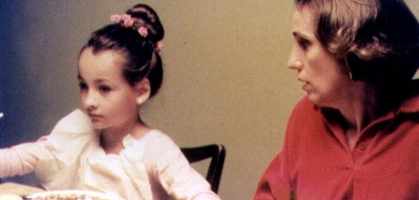
Brandon the bully, wearing loose, grunge-type flannel with a backwards hat, hangs out with a similarly dressed retinue, and at first his actions cement him as the symbol his clothes present him as. However, the eventual turnaround of his character is an especially powerful choice the film makes, and once again the spectator is invited to make sense of the contradictions inherent in these life-like characters (interestingly, Brandon is first seen hatless before taking Dawn to get, as he states, “raped,” and yet the shock of his threat is defused when that scene actually becomes one of the tenderest the film offers, despite its dubious preamble). Steve sports long hair, a guitar and a beaten up car, and the association of his costume to a drifting, romantic troubadour is what both spectator and Dawn first make. However, his suburb-centric, flirtatious indifference soon becomes clear, though later for Dawn than for the spectator.
Dawn’s mother goes quickly from a cheerful, colorfully dressed, heavily-made-up and accessorized suburban socialite to a wreck of a woman who sports hair-curlers and a long robe after Missy’s disappearance, as if she has refused to change into her other persona. Her costume changes exaggerate a duplicity of self and a full-fledged transformation that Hollywood characters rarely betray (at least in one film/in such a hyperbolized manner). Dawn’s brother wears large glasses, tucks his shirt into high-waisted pants, and yet seems to have accepted his destiny (everything he does is with his “college resume” in mind) in ways that a Hollywood version of a nerd might have fought against. And finally, among plentiful other examples, the luau-themed party thrown by Dawn’s family lampoons the American middle-class stereotype of white people trying to spice up get-togethers with hackneyed images of “ethnicity.”
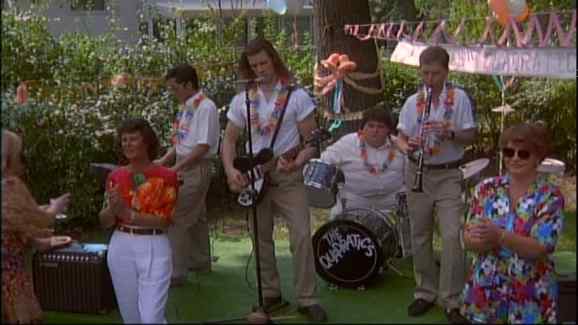
By subverting costumic expectations, Welcome to the Dollhouse problematizes the method of cinematic shortcutting used by Hollywood to do away with ‘time-consuming’ character development in lieu of plot. At the same time, it invites spectators to bring associations into the viewing experience with the hopes that subverting such associations will lead to ambiguity and thus a more involved and ‘playful’ interaction with the film itself.
In sex, lies, and videotape, costume is an even more pronounced method of indie gamesmanship. In a film concerned with four people intimately connected to each other – and also liable to adopt views previously held by another member of the group – as their roles and ideologies change, so too do their costumes.

John, the married lawyer, is first seen in his office, spinning his wedding ring and speaking on the phone about the attention being married gets him from females. In this scene and throughout the film he wears fine suits with suspenders, until the aftermath of his watching Ann’s video, when he is next seen wearing a white suit with a bowtie. With his first outfit, his character easier associates with and emblematizes a certain strand of yuppie culture, with its hedonistic values exhibited most by John; however, the white suit paired with a bowtie is conspicuous and showy, as it reflects a late reach for the innocence and purity associated with white clothes in the film. He no longer yearns to lie, but it is a false and delayed self he projects with his attire. Ann, meanwhile, begins wearing whites, and the natural impulse is to associate her character with purity (she doesn’t have sex until marriage) and innocence (in company of therapist, she refuses to admit to masturbating). The stark difference between her character associations and Cynthia’s is brought out in aesthetic choices made by Soderbergh – in one scene, we are given Ann in the foreground, wearing white in a room painted white while her sister, wearing red and black, is relegated to the background in another room which is painted a reddish hue.
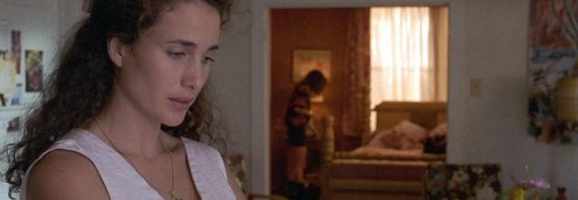
Cynthia, the romantic artist emblematized, wears loose, billowy clothes, and often sports unkempt hair, large glasses, a paintbrush or drink in hand. These details exaggerate her image as in contrast to her sister’s (as does her questioning Graham whether she is “prettier than Ann”), and make Ann’s transformation into someone more Cynthia-like that much more portentous. The two sisters are compartmentalized, and the spectator picks up on the mise-en-scene clues if attempting to play the indie “game.” All of this makes it more conspicuous that once Ann discovers her sister’s earring in her room, she immediately sheds her white pants – from then on Ann curses with a more southern accent (both Cynthia-like characteristics), dresses in black, and the first scene after her attire change is outside as she steps into a car with red interior.
Finally, Graham, dressed in black either to attend a “funeral” or as “an undertaker from the art world,” emblematizes the solemn man dutiful to his own causes, in his case abstaining from lying. He claims to have once been a liar (when he went to college with John), so it may not be absurd to assume he also once wore the same yuppie attire, or at least projected a false image of innocence by wearing white. That the aesthetic choices of costumes/colors were made purposefully gains traction with the comment by the ever-present bar patron, privy to Ann and Cynthia’s conversations, who remarks twice on the fact that he is wearing the same colors as Ann, the final being a simple declaration that “I’m wearing blue, you’re wearing blue.”
The major characters change in the scope of the narrative in the same way as Hollywood characters might, with major revelations to blame, but pairing character changes with the costume changes (costume changes which often borrow from previous characters’ attire) brings an element of formal and aesthetic play into the workings of the film. The portentousness of the costume changes in sex, lies, and videotape emblematizes the characters and highlights their transformations without stooping to moralize as a Hollywood production might feel necessary.

This is all heightened by the lack of closure at the end of Soderbergh’s film, wherein the final shot is of Ann and Graham, dressed in black (after, critic Alice Templeton explains, “Ann has redressed Graham’s repression and illusion,” an interesting word choice if nothing else), but smiling and talking about the weather. It is almost brazen how little closure there is besides their being together: dressed in black but smiling belies any “death” associations the color before made, and talking about the weather is of course the dialogue of insignificance.
Sonic Games
Costume is not the only aesthetic strategy used by these two indie film exemplars to prod spectators on; sound (most notably, dialogue and music) is also relied on for its ability to develop a discourse with Hollywood conventions. And whereas sex, lies, and videotape relies more on mise-en-scene to engage the viewer in the “game” of indie cinema, it is actually Welcome to the Dollhouse which incorporates sound more evidently in its design, albeit by a slight margin. By addressing conventions of dialogue and music, Solondz’s film explores alternative ways in which sound can affect a film viewer. Itself searching for another dialect within the cinematic language, Welcome to the Dollhouse welcomes the spectator into the very same game-like discourse with convention that it partakes in.
In many ways, the narrative revolves around dialogue and the language used by its characters. The harsh language used by the middle-schoolers in the film, while certainly faithful to the American reality, is jarring because it would certainly not be inserted as shamelessly into most Hollywood productions. And while it is first meant to make the film viewer slightly uneasy, once we have become fully integrated into this specific community, we begin to treat the language (specifically the terminology) with sanctity, just as the characters do. Originally meant to subvert notions of adolescent innocence, the language soon becomes something very serious and very much adhered to. Brandon, a connoisseur of risque terminology, calls Dawn every word he can think of, except for one — the word “retard” offends him greatly because his brother is mentally handicapped.
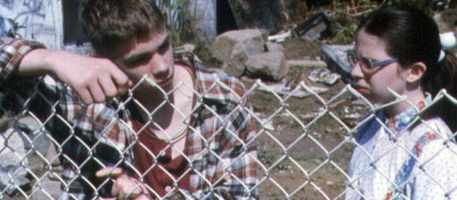
And what an absolute coup that this moment in the film nearly leads us to acclaiming the honor of such a character as Brandon! Further, Dawn explains at one point that “just because he’s a faggot doesn’t mean he’s an asshole,” highlighting the seriousness with which characters treat language, and later on, the humor of Dawn’s “special people club” arises from that same seriousness with which Steve explains to her the naming misstep she has taken. Drawing the viewer into the solemnness with which the characters treat language, Welcome to the Dollhouse effectively engages the viewer on a level which a Hollywood film might not attempt to, for it would be less concerned with the ‘game’ indie cinema yearns to play with convention and audience.
The use of music (or lack thereof) is terrifically important to the film’s purpose of engaging with Hollywood convention. Often noting tropes found in these major productions, or the methodology of musical cues meant to solicit emotion, Solondz’s film relies on the example of Hollywood to move forward with a new dialect of cinematic language. The very first marker of contrarian motives occurs when the garage band (then Steve-less) is shown playing inside of the garage, but within moments the garage-door closes, shutting us off from the music and image of the group. In what Hollywood films would the garage door not be open for the camera to shoot the band with a particular lighting scheme?
Soon we see Dawn running outside of the school after being verbally harassed, all the while accompanied by an angsty guitar riff that will be repeated several times throughout the film. The scene’s humor arises from the juxtaposition of her supposedly deep angst with the fact of the moment’s triviality as well as her age. This is the first indication that characters in the film will become emblems by means of sonic association. By pairing images of certain characters with hand-picked music, Solondz anticipates Hollywood sonic conventions brought by the viewer into the theater and then exploits them for comedic effect. Missy is always accompanied by a Nutcracker suite piano piece which hyperbolizes her innocent character, Steve by the garage band song which Dawn worships and which reflects her outsized image of him.

Musical cues are also tampered with, generally in order to counteract Hollywood emotional direction and simplicity. Angelic music plays over the long-shot image of Brandon and Dawn heading to a decrepit junkyard for his promised “rape,” no music plays over the images (shot person by person) of Dawn’s family eating her cake while she cannot, no music plays when Dawn lifts the hammer over her sister’s sleeping head, and music from Swan Lake plays over the image of Dawn, her mother and brother at the dinner table (where at this point Missy is missing and her father is sick). All of these moments are striking in their countering of convention, and draw the viewer into the “game,” while the final example is especially interesting because the music is from a musical about transformation, yet, ironically, the characters have not changed at all: Dawn’s mother is still absurd and has only wiped away her makeup to reveal her unhinged self adorned with a bathrobe; Dawn is still unhappy with her family situation; her father is still absent from the family dynamic, just as he was before Missy’s disappearance.
Despite the dearth of musical cues in these scenes, they do not lack tension, for the very absence of sound becomes unnerving. Another method Solondz uses to sonic effect is related to diegesis: whether through voiceover or music, misplaced or absent musical cues create a sense of tension. As Dawn looks at her hands in a mirror, a flashback voiceover recounts a girl’s statement that she and Steve “finger-fucked,” as if we are given access to Dawn’s thoughts. The combination of the voiceover and image of adolescent Dawn looking at her fingers is off-putting, for we expect that she may try something similar. The final scene of the film is of Dawn morosely singing along with her classmates on the bus to Disney World, and, suddenly, as the camera zooms in on her face, the other children’s voices drown out, the image of her mouth moving and the song she sings become temporally disunited, and her song appears to become non-diegetic.

This is a strange choice, and certainly interrupts the narrative by means of spectator contemplation, a phenomenon which in turn “has the effect of isolating the object of the gaze, of momentarily freeing it from its narrative function.” In other words, Dawn becomes momentarily freed from the narrative; an object entrenched in the indie cinema tradition and to be contemplated free of convention or plot.
The dialogue in sex, lies, and videotape is unsettling both in its frankness and its self-reflexivity. Characters speak of masturbating, impotency, and erections, among other conventionally taboo sexual topics, and they do so quietly, stuttering, and without quick cuts or sound effects to direct a viewer to laughter or emotional connection. Much of the humor arises from the hyper-realism of the dialogue in conjunction with the film’s anti-Hollywood editing (we are not released from tension in either the barbed dinner table scene with Graham, John, and Ann or in the lunch scene with Graham and Ann where Graham reveals his impotency while both characters are in frame). The self-reflexivity of the dialogue, which Templeton explains is not “so intrusive as to disrupt our involvement with the characters and plot,” is often evident as a result of editing as well. Ann tells her therapist that John near “had a stroke” when she began to get fat, but the next shot is of him smiling as he breezily twirls his wedding ring with indifference.
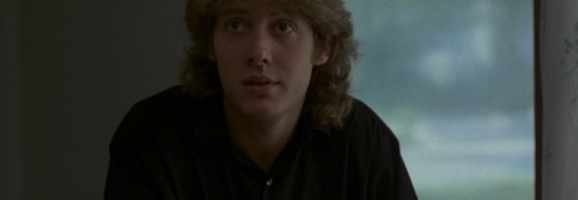
While at lunch with Ann, Graham waxes eloquent on love and Ann responds by exclaiming how “beautiful, really beautiful” his statement was, to which he responds in deadpan: “I was only quoting.” These various moments exist as ‘winks’ by the film to the spectator; miniature invitations to observe the contradiction and complexity of the characters and thus of the film itself.
The most obvious non-diegetic sound in the film is an ambient, ponderous piece of music repeated several times, and always when a character is being voyeuristic. It first plays while Ann sneaks up to spy on Graham as he sleeps on the couch in her house, next plays over the tape of Cynthia as Graham watches naked, next as soon as Graham turns the tape on to record Ann, next while John watches Ann’s tape after barging into Graham’s apartment, and lastly after Graham’s final piece of dialogue about “rain.” That penultimate time is interesting, for the music cuts off at precisely the moment when Graham turns the videocamera off to have sex with Ann — the music turns to white noise, almost as if the supposedly non-diegetic music was in fact diegetic within the confines of Graham’s tape, or more generally, within the confines of voyeuristic behavior.
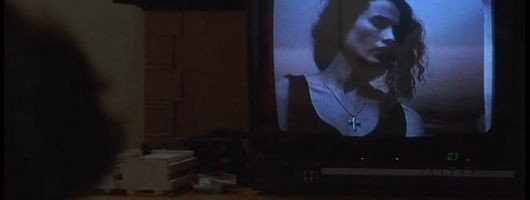
Which makes the final example of the music extremely eerie and incriminating, for it leads one to believe that while Graham and Ann have escaped the confines of voyeurism, there remains one person who has not: the spectator. We cannot see the rain they speak of, and the absence of closure comes from our desire to see if in fact it is raining — we itch to continue as voyeurs despite the lessons of the film; a highly subversive and invasive final touch by Soderbergh. In his film as well as Solondz’s, discourse with convention allows Soderbergh to address the spectator on various levels, often inviting them to play the indie cinema ‘game,’ but always redefining the scope and effectiveness of cinematic language. As Solondz says so tellingly: “Part of the process of growing up is beginning to understand the reality underlying the fantasies we may have or the language that we use. […] it jolts you in a way that forces you to grow up.”
Works Cited
Cross, Alice. “Surviving adolescence with dignity; an interview with Todd Solondz.” Cineaste, Vol. 23, No. 3, June 1996.
Lefebrve, Martin. “Between Setting and Landscape in the Cinema.” Landscape and Film. Routledge 2006: n. pag. Print.
Newman, Michael. “Indie Cinema: Viewing Strategies.” Indie: An American Film Culture, New York: Columbia University Press, 2011, pp. 21-27.
Newman, Michael. “Welcome to the Dollhouse: Emblematizing the Outsider.” Indie: An American Film Culture, pp. 116-124.
Templeton, Alice. “The Confessing Animal in sex, lies, and videotape.” Journal of Film and Video, Vol. 50, No. 2 (Summer 1998), pp. 15-25.
What do you think? Leave a comment.











I’ve seen Welcome to the Dollhouse and it almost felt like watching a documentary on how hard life can be for a kid perceived like ugly by others kids. So yeah you see everything she goes through, how hard it is for her, and how she can sometimes become an bitch herself (especially towards her little sister, who also often is an bitch btw) …ok sure but what’s the point?
I think this movie just show but there is no big news in it, we all went to school and there was always “victim ugly kids” like that, and this is bad, but so what? This movie was too much a description, a slice of the life of this kid with no real start and no real end (the movie could have started earlier/later, could have ended earlier/later)
Though they deal with totally different topics, this movie reminded me a lot of dazed of confused, also a quite good movie but with no real point, just a description, between documentary and movie.
Some movies aren’t meant to be ultra climatic. I actually appreciate indie films because they don’t have to ascribe to the typical model that major motion pictures have to. I think because of the way major films are, it feels odd or lacking when a movie happens to be slow paced or doesn’t portray an apparent position (or message) for the viewers to either agree or disagree with.
This film, like others, may simply exist only to tell a story and provide a perspective, and that’s it. It gives us an opportunity to really be able to relate to the characters or situations, without any filler getting in the way or distracting from any possible true emotional connections; and it allows for immediate, intense and patient personal reflection.
So, to answer your question, I don’t know if there was any real “point,” but for me, it gave my experiences, during grade school, of being an awkward nerd, a voice and some closure. Like a piece of art, it simply spoke to me…and I guess “for me,” that was the point- and maybe for these types of movies, you have to find what “point” it served as for you.
Exactly. I actually first saw Welcome to the Dollhouse with a group of British people, and afterwards they asked me (an American) whether school life in the U.S. matches up with how it’s depicted in the film. That was their first question, and it leads me to believe that at some point they began seeing the film as a sort of documentary — but this neither detracted from their enjoyment of the film nor barred them from finding what point it served for them. They found a way to engage with the material on screen, and by taking an active role (playing with the film, i.e., shifting it from a fictional feature film to a documentary) they were learning how to be sophisticated spectators. The potential for that sort of education is much of what I find valuable in independent films like Welcome to the Dollhouse.
And obviously “fictional feature films” and “documentaries” are not mutually exclusive categories, but hopefully the gist of my point made it through.
It’s more than just the ugly girl girl in school. Her family mistreats/doesn’t really pay her attention or respect. Also, she does get reassurance a few times in the movie. Like she asks her brother if she has a chance with Steve (the dude in the band) and her brother says he will get with any girl who is willing. Also the rebel kid Brandon was into her. The movie doesn’t really have to be plot or story driven. The performance by all the actors were really wonderful. You can understand their pain.
Both of these titles had excellent acting, writing and directing, everything I ask for a movie. Creative and intense plot, quite pioneering and ground-breaking for the time the movies were made.
I haven’t seen Welcom to the Dollhouse but I do agree with you about sex, lies, and videotape. Such an awesome movie, I just wish it was more talked about today.
I loved Sex, Lies & Videotape and fell for James Spader! The subtely of his acting was amazing. Every time he touched Ann, I was wishing it was me. lol! He isn’t a pretty boy but that’s what makes him SOOO sexy!
I actually fell for him in Stargate (saw that one first) but sex lies and videotape sealed the deal. I love the intimacy at the end between Ann and Graham, when he she sits next to him and he touches her arm…
Oh, heh, James Spader freaks:
Watch Secretary.
This was an excellent piece. Thank you for demonstrating care and rigor in your thinking.
i was quite dissapointent with the ending of welcoem to the dollhouse as i was expecting it to be happy but instead all her problems are still there
I always thought it was a happy ending of sorts. Yeah, nothing changed, but focusing on her voice over the chorus of people on the bus seemed to signify that she would survive and rise above everything…but then she goes and kills herself…*Sigh* a pity.
I liked it. I like how it showed her on a crowded bus but still very isolated just the same. Well, I didn’t like like it, it was sad but she was as alone in the end as in the beginning.
i loved the ending. so much sadness. the future still looks bleak…. it is pretty obvious to me that solondz “likes” torturing his characters (while refusing to portray them as victims). a bit like lars von trier. so, the happy ending is pretty much the last thing i would expect from him….
I liked the ending a lot, especially since it seemed to fit what Mark was saying perfectly- 8th grade is kind of better than 7th grade, but it still sucks, 9th grade is kind of better than 8th grade, but it still sucks, etc. Your problems aren’t resolved all at once just based on anything, even time, like the end of a movie. You just keep going and tolerate it. Dawn on the bus was just putting up with more dumb crap she didn’t want to, maybe not happily or sadly, but she was going through the motions and surviving it well enough, and that’s all you can really hope to do.
It’s actually pretty disappointing to me that Dawn’s story was wrapped up at all. This movie seems so much better as a composite for every frustrated middle school kid than an investigation of a particular person. Just my opinion though.
Very interesting piece! I haven’t seen either of these films but this article certainly grabs my interest. They seem like really important cinematic works.
“Welcome to the Dollhouse” is a must.
Sex, Lies, and Videotape is one of those flicks that wants to be a serious look at relationships, sex, and love but comes off as a jilted woman’s self-therapy project. Same silly rom-com elements. No real accountability for all those women taping themselves with a strange guy and just trusting in his heart to not leak them?
So disagree here. Might be my favorite Soderbergh film. Simple yet effective.
Mine too. It’s a favourite film of mine. I think it’s Sodeerbergh’s best film. Interesting subject matter for a film.
Welcome to the Dollhouse is such a vague and subtle little piece of cinema, barely cinema, horrifying and garishly colored. I loved it back then and I love it now.
Great piece.
Definitely a darker side of the 90s.